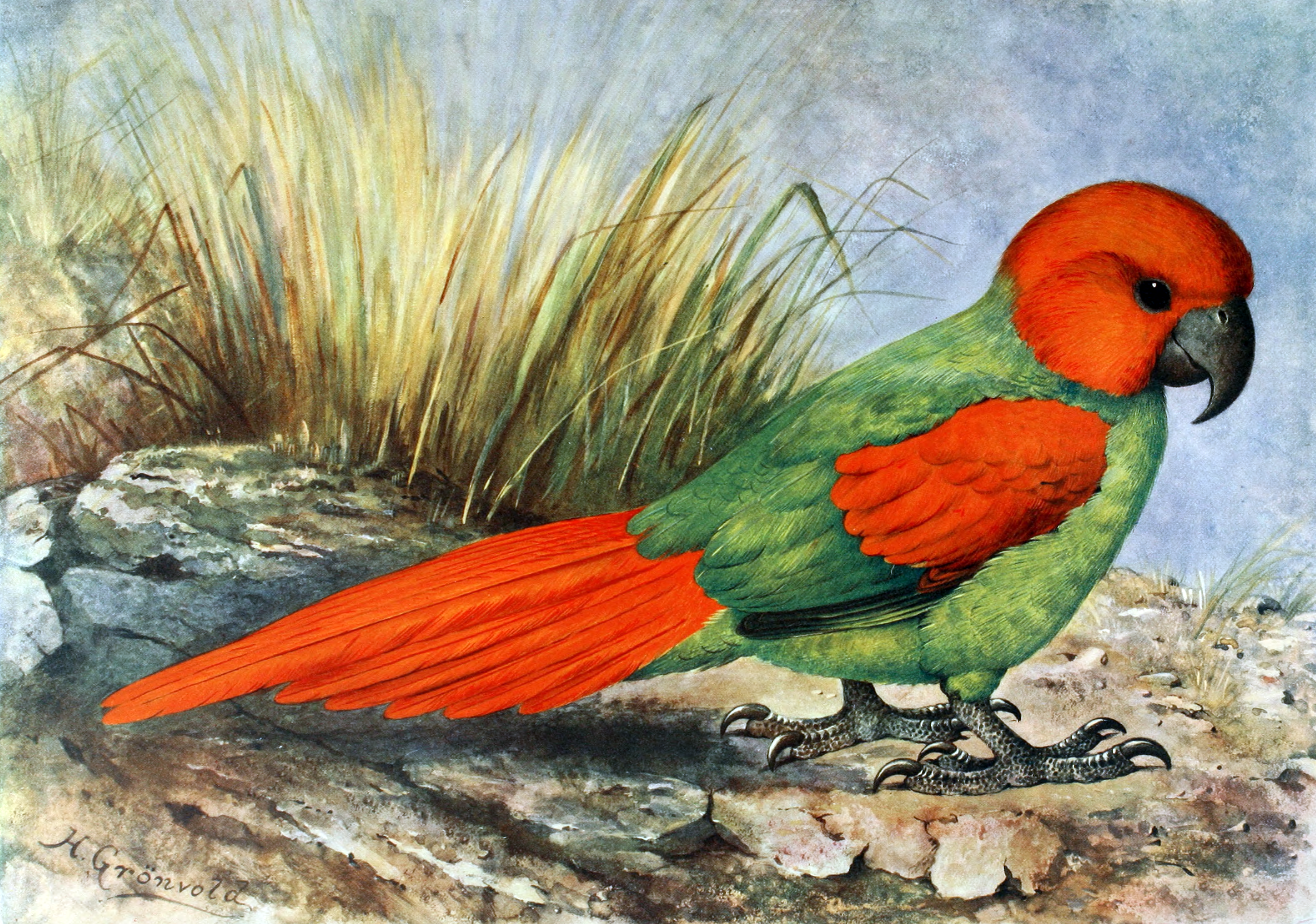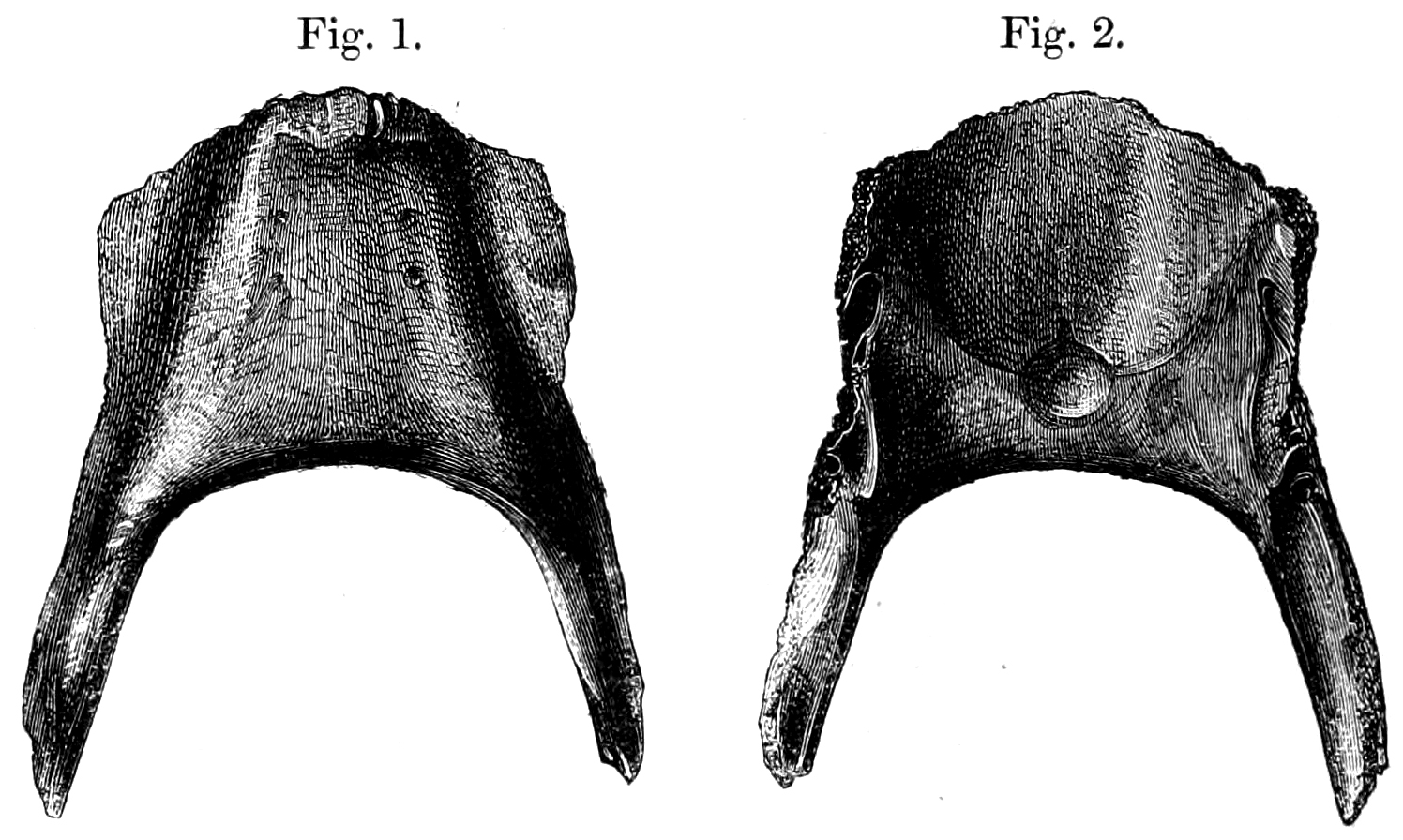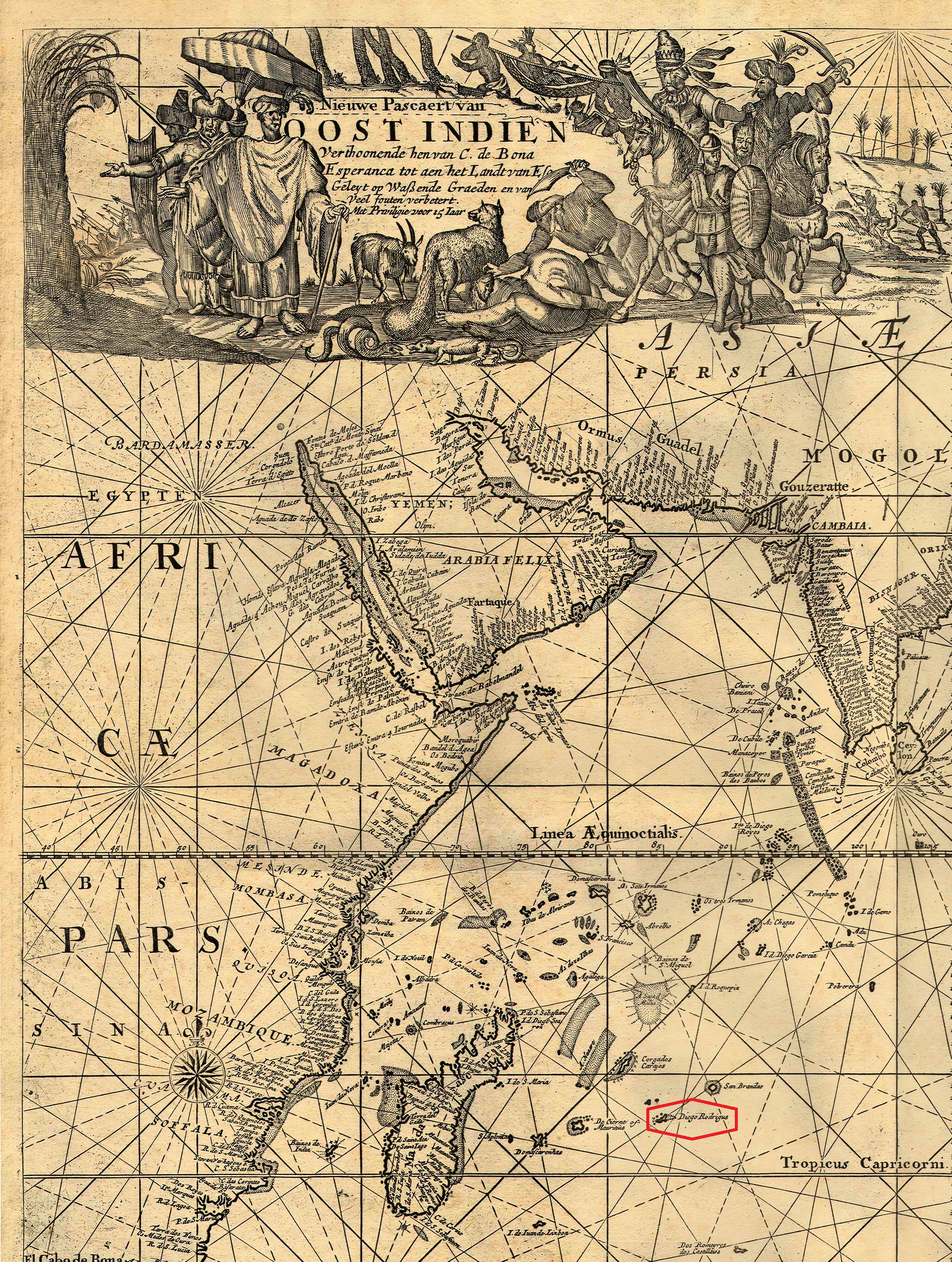|
Necropsittacus
The Rodrigues parrot or Leguat's parrot (''Necropsittacus rodricanus'') is an extinct species of parrot that was endemic to the Mascarene island of Rodrigues in the Indian Ocean, east of Madagascar. It is unclear to which other species it is most closely related, but it is classified as a member of the tribe Psittaculini, along with other Mascarene parrots. The Rodrigues parrot bore similarities to the broad-billed parrot of Mauritius, and may have been related. Two additional species have been assigned to its genus (''N. francicus'' and ''N. borbonicus''), based on descriptions of parrots from the other Mascarene islands, but their identities and validity have been debated. The Rodrigues parrot was green, and had a proportionally large head and beak and a long tail. Its exact size is unknown, but it may have been around long. It was the largest parrot on Rodrigues, and it had the largest head of any Mascarene parrot. It may have looked similar to the great-billed parrot. By t ... [...More Info...] [...Related Items...] OR: [Wikipedia] [Google] [Baidu] |
Rodrigues Parrot
The Rodrigues parrot or Leguat's parrot (''Necropsittacus rodricanus'') is an extinct species of parrot that was endemic to the Mascarene island of Rodrigues in the Indian Ocean, east of Madagascar. It is unclear to which other species it is most closely related, but it is classified as a member of the tribe Psittaculini, along with other Mascarene parrots. The Rodrigues parrot bore similarities to the broad-billed parrot of Mauritius, and may have been related. Two additional species have been assigned to its genus (''N. francicus'' and ''N. borbonicus''), based on descriptions of parrots from the other Mascarene islands, but their identities and validity have been debated. The Rodrigues parrot was green, and had a proportionally large head and beak and a long tail. Its exact size is unknown, but it may have been around long. It was the largest parrot on Rodrigues, and it had the largest head of any Mascarene parrot. It may have looked similar to the great-billed parrot. By ... [...More Info...] [...Related Items...] OR: [Wikipedia] [Google] [Baidu] |
Psittaculini
Psittaculini is a tribe of parrots of the family Psittaculidae. The subdivisions within the tribe are controversial. Tribe Psittaculini * Genus ''Psittinus'' ** Blue-rumped parrot, ''Psittinus cyanurus'' ** Simeulue parrot, ''Psittinus abbotti'' * Genus '' Geoffroyus'' ** Red-cheeked parrot, ''Geoffroyus geoffroyi'' ** Blue-collared parrot, ''Geoffroyus simplex'' ** Song parrot, ''Geoffroyus heteroclitus'' ** Rennell parrot, ''Geoffroyus hyacinthinus'' * Genus ''Prioniturus'' ** Montane racket-tail, ''Prioniturus montanus'' ** Mindanao racket-tail, ''Prioniturus waterstradti'' ** Blue-headed racket-tail, ''Prioniturus platenae'' ** Green racket-tail, ''Prioniturus luconensis'' ** Blue-crowned racket-tail, ''Prioniturus discurus'' ** Blue-winged racket-tail, ''Prioniturus verticalis'' (also known as Sulu Racquet-tail) ** Yellow-breasted racket-tail, ''Prioniturus flavicans'' ** Golden-mantled racket-tail, ''Prioniturus platurus'' ** Buru racket-tail, ''Prioniturus mada'' ... [...More Info...] [...Related Items...] OR: [Wikipedia] [Google] [Baidu] |
Broad-billed Parrot
The broad-billed parrot or raven parrot (''Lophopsittacus mauritianus'') is a large extinct parrot in the family Psittaculidae. It was endemic to the Mascarene island of Mauritius in the Indian Ocean east of Madagascar. It is unclear what other species it is most closely related to, but it has been classified as a member of the tribe Psittaculini, along with other Mascarene parrots. It had similarities with the Rodrigues parrot (''Necropsittacus rodricanus''), and may have been closely related. The broad-billed parrot's head was large in proportion to its body, and there was a distinct crest of feathers on the front of the head. The bird had a very large beak, comparable in size to that of the hyacinth macaw, which would have enabled it to crack hard seeds. Subfossil bones indicate that the species exhibited greater sexual dimorphism in overall size and head size than any living parrot. The exact colouration is unknown, but a contemporary description indicates that it had mu ... [...More Info...] [...Related Items...] OR: [Wikipedia] [Google] [Baidu] |
Subfossil
A fossil (from Classical Latin , ) is any preserved remains, impression, or trace of any once-living thing from a past geological age. Examples include bones, shells, exoskeletons, stone imprints of animals or microbes, objects preserved in amber, hair, petrified wood and DNA remnants. The totality of fossils is known as the ''fossil record''. Paleontology is the study of fossils: their age, method of formation, and evolutionary significance. Specimens are usually considered to be fossils if they are over 10,000 years old. The oldest fossils are around 3.48 billion years old to 4.1 billion years old. Early edition, published online before print. The observation in the 19th century that certain fossils were associated with certain rock strata led to the recognition of a geological timescale and the relative ages of different fossils. The development of radiometric dating techniques in the early 20th century allowed scientists to quantitatively measure the absolute ... [...More Info...] [...Related Items...] OR: [Wikipedia] [Google] [Baidu] |
Rostrum (anatomy)
Rostrum (from Latin ', meaning ''beak'') is a term used in anatomy for a number of phylogenetically unrelated structures in different groups of animals. Invertebrates * In crustaceans, the rostrum is the forward extension of the carapace in front of the eyes. It is generally a rigid structure, but can be connected by a hinged joint, as seen in Leptostraca. * Among insects, the rostrum is the name for the piercing mouthparts of the order Hemiptera as well as those of the snow scorpionflies, among many others. The long snout of weevils is also called a rostrum. * Gastropod molluscs have a rostrum or proboscis. * Cephalopod molluscs have hard beak-like mouthparts referred to as the rostrum. File:Washington DC Zoo - Macrobrachium rosenbergii 6.jpg, Crustacean: the rostrum of the shrimp ''Macrobrachium rosenbergii'' is serrated along both edges. File:Gminatus australis with Beetle.jpg, Insect: assassin bug piercing its prey with its rostrum File:Architeuthis beak.jpg, Cephalopod: ... [...More Info...] [...Related Items...] OR: [Wikipedia] [Google] [Baidu] |
Holotype
A holotype is a single physical example (or illustration) of an organism, known to have been used when the species (or lower-ranked taxon) was formally described. It is either the single such physical example (or illustration) or one of several examples, but explicitly designated as the holotype. Under the International Code of Zoological Nomenclature (ICZN), a holotype is one of several kinds of name-bearing types. In the International Code of Nomenclature for algae, fungi, and plants (ICN) and ICZN, the definitions of types are similar in intent but not identical in terminology or underlying concept. For example, the holotype for the butterfly '' Plebejus idas longinus'' is a preserved specimen of that subspecies, held by the Museum of Comparative Zoology at Harvard University. In botany, an isotype is a duplicate of the holotype, where holotype and isotypes are often pieces from the same individual plant or samples from the same gathering. A holotype is not necessarily "typ ... [...More Info...] [...Related Items...] OR: [Wikipedia] [Google] [Baidu] |
IOC World Bird List
''Birds of the World: Recommended English Names'' is a paperback book, written by Frank Gill and Minturn Wright on behalf of the International Ornithologists' Union. The book is an attempt to produce a standardized set of English names for all bird species, and it is the product of a project set in motion at the 1990 International Ornithological Congress. It is supplemented by a website, the IOC World Bird List, giving updates to the published material. An 11-page introduction deals with a number of issues which relate to the naming of birds. This is followed by a systematic list, from pages 12 to 211, and a 46-page index. The family sequence is that of the third edition of the '' Howard and Moore Complete Checklist of the Birds of the World''. The book's cover is illustrated with a photo of a helmet vanga, a bird endemic to Madagascar.Gill, Frank, and Minturn Wright, ''Birds of the World: Recommended English Names''; Princeton University Press, 2006. Background Since the pion ... [...More Info...] [...Related Items...] OR: [Wikipedia] [Google] [Baidu] |
Diogo Rodrigues
Dom Diogo Rodrigues, Dom Diogo Roiz (; Lagos, Portugal – 21 April 1577; Colvá, Goa) was a Portuguese explorer of the Indian Ocean who sailed as an ordinary helmsmanAuguste Toussaint, ''History of the Indian Ocean'' (Chicago: University Press, 1966), pp. 109 under the command of Dom Pedro Mascarenhas around Goa. They sailed from the Cape of Good Hope eastward into little-known waters of the newly discovered route to Goa. Rodrigues island was named after him between 4 and 9 February 1528 because he had discovered it during his only return journey from Goa via Cochin (left on 15 January 1528) to Lisbon, where he was elevated to the rank of a knight (''cavaleiro'') by John III of Portugal. He then returned to Goa and made a mark in the history of the Portuguese empire in the subcontinent around the mid-16th century. Exploration and Diogo Rodrigues In the early 16th century, Dom Diogo Fernandes Pereira was appointed captain of a Setúbal ship bound for Goa. He is said to ... [...More Info...] [...Related Items...] OR: [Wikipedia] [Google] [Baidu] |
Specific Name (zoology)
In zoological nomenclature, the specific name (also specific epithet or species epithet) is the second part (the second name) within the scientific name of a species (a binomen). The first part of the name of a species is the name of the genus or the generic name. The rules and regulations governing the giving of a new species name are explained in the article species description. For example, the scientific name for humans is ''Homo sapiens'', which is the species name, consisting of two names: ''Homo'' is the " generic name" (the name of the genus) and ''sapiens'' is the "specific name". Historically, ''specific name'' referred to the combination of what are now called the generic and specific names. Carl Linnaeus, who formalized binomial nomenclature, made explicit distinctions between specific, generic, and trivial names. The generic name was that of the genus, the first in the binomial, the trivial name was the second name in the binomial, and the specific the proper term for ... [...More Info...] [...Related Items...] OR: [Wikipedia] [Google] [Baidu] |
Psittacus
''Psittacus'' is a genus of African grey parrots in the subfamily Psittacinae. It contains the two species: the grey parrot (''Psittacus erithacus'') and the Timneh parrot (''Psittacus timneh''). For many years, the grey parrot and Timneh parrot were classified as subspecies; the former as the nominate, the latter as ''P. e. timneh''. However, in 2012 the taxa were recognized as separate species by BirdLife International on the basis of genetic, morphological, plumage and vocal differences. These parrots are found in the primary and secondary rainforest of West and Central Africa. They are among the most intelligent birds in the world. They feed primarily on palm nuts, seeds, fruits, and leafy matter, but have also been observed eating snails. Their inclination and ability to mimic speech and other sounds have made them popular pets. Taxonomy The genus ''Psittacus'' was introduced in 1758 by the Swedish naturalist Carl Linnaeus in the tenth edition of his ''Systema Naturae'' ... [...More Info...] [...Related Items...] OR: [Wikipedia] [Google] [Baidu] |
Scientifically Described
A species description is a formal description of a newly discovered species, usually in the form of a scientific paper. Its purpose is to give a clear description of a new species of organism and explain how it differs from species that have been described previously or are related. In order for species to be validly described, they need to follow guidelines established over time. Zoological naming requires adherence to the ICZN code, plants, the ICN, viruses ICTV, and so on. The species description often contains photographs or other illustrations of type material along with a note on where they are deposited. The publication in which the species is described gives the new species a formal scientific name. Some 1.9 million species have been identified and described, out of some 8.7 million that may actually exist. Millions more have become extinct throughout the existence of life on Earth. Naming process A name of a new species becomes valid (available in zool ... [...More Info...] [...Related Items...] OR: [Wikipedia] [Google] [Baidu] |
1761 Transit Of Venus
file:Venus transit symbol.svg, frameless, upright=0.5 A transit of Venus across the Sun takes place when the planet Venus passes directly between the Sun and a inferior and superior planets, superior planet, becoming visible against (and hence obscuring a small portion of) the solar disk. During a astronomical transit, transit, Venus can be seen from Earth as a small black dot moving across the face of the Sun. The duration of such transits is usually several hours (the transit of 2012 lasted 6 hours and 40 minutes). A transit Occultation#Occultations, transits and eclipses, is similar to a solar eclipse by the Moon. While the diameter of Venus is more than three times that of the Moon, Venus appears smaller, and travels more slowly across the face of the Sun, because it is much farther away from Earth. Transits of Venus are among the rarest of predictable astronomical phenomena. They occur in a pattern that generally repeats every 243 years, with pairs of transits eight years a ... [...More Info...] [...Related Items...] OR: [Wikipedia] [Google] [Baidu] |




.jpg)


